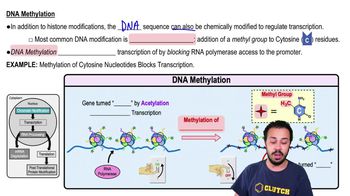Table of contents
- 1. Introduction to Biology2h 42m
- 2. Chemistry3h 40m
- 3. Water1h 26m
- 4. Biomolecules2h 23m
- 5. Cell Components2h 26m
- 6. The Membrane2h 31m
- 7. Energy and Metabolism2h 0m
- 8. Respiration2h 40m
- 9. Photosynthesis2h 49m
- 10. Cell Signaling59m
- 11. Cell Division2h 47m
- 12. Meiosis2h 0m
- 13. Mendelian Genetics4h 44m
- Introduction to Mendel's Experiments7m
- Genotype vs. Phenotype17m
- Punnett Squares13m
- Mendel's Experiments26m
- Mendel's Laws18m
- Monohybrid Crosses19m
- Test Crosses14m
- Dihybrid Crosses20m
- Punnett Square Probability26m
- Incomplete Dominance vs. Codominance20m
- Epistasis7m
- Non-Mendelian Genetics12m
- Pedigrees6m
- Autosomal Inheritance21m
- Sex-Linked Inheritance43m
- X-Inactivation9m
- 14. DNA Synthesis2h 27m
- 15. Gene Expression3h 20m
- 16. Regulation of Expression3h 31m
- Introduction to Regulation of Gene Expression13m
- Prokaryotic Gene Regulation via Operons27m
- The Lac Operon21m
- Glucose's Impact on Lac Operon25m
- The Trp Operon20m
- Review of the Lac Operon & Trp Operon11m
- Introduction to Eukaryotic Gene Regulation9m
- Eukaryotic Chromatin Modifications16m
- Eukaryotic Transcriptional Control22m
- Eukaryotic Post-Transcriptional Regulation28m
- Eukaryotic Post-Translational Regulation13m
- 17. Viruses37m
- 18. Biotechnology2h 58m
- 19. Genomics17m
- 20. Development1h 5m
- 21. Evolution3h 1m
- 22. Evolution of Populations3h 52m
- 23. Speciation1h 37m
- 24. History of Life on Earth2h 6m
- 25. Phylogeny2h 31m
- 26. Prokaryotes4h 59m
- 27. Protists1h 12m
- 28. Plants1h 22m
- 29. Fungi36m
- 30. Overview of Animals34m
- 31. Invertebrates1h 2m
- 32. Vertebrates50m
- 33. Plant Anatomy1h 3m
- 34. Vascular Plant Transport1h 2m
- 35. Soil37m
- 36. Plant Reproduction47m
- 37. Plant Sensation and Response1h 9m
- 38. Animal Form and Function1h 19m
- 39. Digestive System1h 10m
- 40. Circulatory System1h 57m
- 41. Immune System1h 12m
- 42. Osmoregulation and Excretion50m
- 43. Endocrine System1h 4m
- 44. Animal Reproduction1h 2m
- 45. Nervous System1h 55m
- 46. Sensory Systems46m
- 47. Muscle Systems23m
- 48. Ecology3h 11m
- Introduction to Ecology20m
- Biogeography14m
- Earth's Climate Patterns50m
- Introduction to Terrestrial Biomes10m
- Terrestrial Biomes: Near Equator13m
- Terrestrial Biomes: Temperate Regions10m
- Terrestrial Biomes: Northern Regions15m
- Introduction to Aquatic Biomes27m
- Freshwater Aquatic Biomes14m
- Marine Aquatic Biomes13m
- 49. Animal Behavior28m
- 50. Population Ecology3h 41m
- Introduction to Population Ecology28m
- Population Sampling Methods23m
- Life History12m
- Population Demography17m
- Factors Limiting Population Growth14m
- Introduction to Population Growth Models22m
- Linear Population Growth6m
- Exponential Population Growth29m
- Logistic Population Growth32m
- r/K Selection10m
- The Human Population22m
- 51. Community Ecology2h 46m
- Introduction to Community Ecology2m
- Introduction to Community Interactions9m
- Community Interactions: Competition (-/-)38m
- Community Interactions: Exploitation (+/-)23m
- Community Interactions: Mutualism (+/+) & Commensalism (+/0)9m
- Community Structure35m
- Community Dynamics26m
- Geographic Impact on Communities21m
- 52. Ecosystems2h 36m
- 53. Conservation Biology24m
15. Gene Expression
Introduction to Translation
Problem 9`
Textbook Question
Within a cell, the amount of protein made using a given mRNA molecule depends partly on
a. The degree of DNA methylation
b. The rate at which the mRNA is degraded
c. The number of introns present in the mRNA
d. The types of ribosomes present in the cytoplasm
 Verified step by step guidance
Verified step by step guidance1
Understand that mRNA molecules are templates for protein synthesis during translation. The amount of protein produced is influenced by several factors related to mRNA stability and translation efficiency.
Consider the role of mRNA degradation: The rate at which mRNA is degraded affects how long it is available for translation. Faster degradation means less time for ribosomes to synthesize proteins, resulting in less protein production.
Evaluate the impact of DNA methylation: While DNA methylation affects gene expression at the transcriptional level, it does not directly influence the amount of protein made from mRNA. Therefore, it is less relevant to this specific question.
Analyze the presence of introns: Introns are non-coding regions removed during mRNA processing. The number of introns does not directly affect the amount of protein produced from mature mRNA, as they are not present in the final mRNA used for translation.
Consider the types of ribosomes: Different types of ribosomes can affect translation efficiency, but the primary factor in this context is the rate of mRNA degradation, which directly influences protein production.
 Verified video answer for a similar problem:
Verified video answer for a similar problem:This video solution was recommended by our tutors as helpful for the problem above
Video duration:
1mPlay a video:
Was this helpful?
Key Concepts
Here are the essential concepts you must grasp in order to answer the question correctly.
mRNA Degradation
mRNA degradation is a crucial process that determines the lifespan of mRNA molecules in the cytoplasm, affecting the amount of protein synthesized. The rate at which mRNA is degraded influences how long it can be translated by ribosomes, thus impacting protein production levels. Regulatory mechanisms, such as RNA-binding proteins and microRNAs, play significant roles in controlling mRNA stability.
Recommended video:
Guided course

2) mRNA Protection in the Cytoplasm
DNA Methylation
DNA methylation involves the addition of methyl groups to DNA, typically at cytosine bases, affecting gene expression. While it primarily regulates transcription, its indirect effects can influence mRNA levels available for translation. High methylation can lead to gene silencing, reducing mRNA synthesis and subsequently affecting protein production.
Recommended video:
Guided course

DNA Methylation
Ribosome Types
Ribosomes are the cellular machinery responsible for translating mRNA into proteins. Different types of ribosomes, such as free ribosomes and those bound to the endoplasmic reticulum, can affect protein synthesis. The presence and availability of specific ribosome types in the cytoplasm can influence the efficiency and location of protein production within the cell.
Recommended video:
Guided course

Ribosomes

 6:12m
6:12mWatch next
Master Introduction to Translation with a bite sized video explanation from Jason
Start learningRelated Videos
Related Practice














